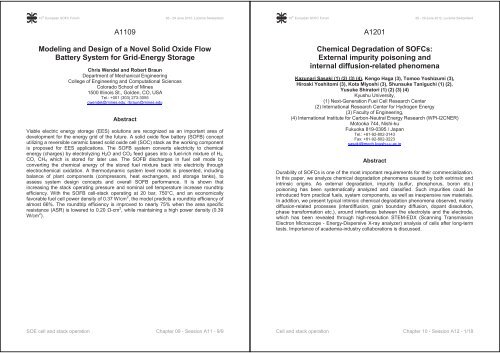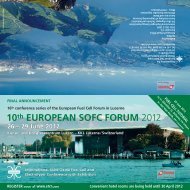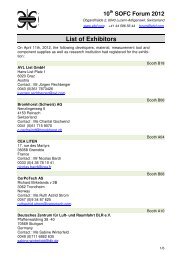Conference Agenda - European Fuel Cell Forum
Conference Agenda - European Fuel Cell Forum
Conference Agenda - European Fuel Cell Forum
Create successful ePaper yourself
Turn your PDF publications into a flip-book with our unique Google optimized e-Paper software.
10 th <strong>European</strong> SOFC <strong>Forum</strong> 26 - 29 June 2012, Lucerne Switzerland<br />
A1109<br />
Modeling and Design of a Novel Solid Oxide Flow<br />
Battery System for Grid-Energy Storage<br />
Chris Wendel and Robert Braun<br />
Department of Mechanical Engineering<br />
College of Engineering and Computational Sciences<br />
Colorado School of Mines<br />
1500 Illinois St., Golden, CO, USA<br />
Tel.: +001 (303) 273-3055<br />
cwendel@mines.edu; rbraun@mines.edu<br />
Abstract<br />
Viable electric energy storage (EES) solutions are recognized as an important area of<br />
development for the energy grid of the future. A solid oxide flow battery (SOFB) concept<br />
utilizing a reversible ceramic based solid oxide cell (SOC) stack as the working component<br />
is proposed for EES applications. The SOFB system converts electricity to chemical<br />
energy (charges) by electrolyzing H2O and CO2 feed gases into a fuel-rich mixture of H2,<br />
CO, CH4 which is stored for later use. The SOFB discharges in fuel cell mode by<br />
converting the chemical energy of the stored fuel mixture back into electricity through<br />
electrochemical oxidation. A thermodynamic system level model is presented, including<br />
balance of plant components (compressors, heat exchangers, and storage tanks), to<br />
assess system design concepts and overall SOFB performance. It is shown that<br />
increasing the stack operating pressure and nominal cell temperature increase roundtrip<br />
efficiency. With the SOFB cell-stack operating at 20 bar, 750°C, and an economically<br />
favorable fuel cell power density of 0.37 W/cm 2 , the model predicts a roundtrip efficiency of<br />
almost 66%. The roundtrip efficiency is improved to nearly 75% when the area specific<br />
resistance (ASR) is lowere�����������-cm 2 , while maintaining a high power density (0.39<br />
W/cm 2 ).<br />
SOE cell and stack operation Chapter 09 - Session A11 - 9/9<br />
10 th <strong>European</strong> SOFC <strong>Forum</strong> 26 - 29 June 2012, Lucerne Switzerland<br />
A1201<br />
Chemical Degradation of SOFCs:<br />
External impurity poisoning and<br />
internal diffusion-related phenomena<br />
Kazunari Sasaki (1) (2) (3) (4), Kengo Haga (3), Tomoo Yoshizumi (3),<br />
Hiroaki Yoshitomi (3), Kota Miyoshi (3), Shunsuke Taniguchi (1) (2),<br />
Yusuke Shiratori (1) (2) (3) (4)<br />
Kyushu University,<br />
(1) Next-Generation <strong>Fuel</strong> <strong>Cell</strong> Research Center<br />
(2) International Research Center for Hydrogen Energy<br />
(3) Faculty of Engineering,<br />
(4) International Institute for Carbon-Neutral Energy Research (WPI-I2CNER)<br />
Motooka 744, Nishi-ku<br />
Fukuoka 819-0395 / Japan<br />
Tel.: +81-92-802-3143<br />
Fax: +81-92-802-3223<br />
sasaki@mech.kyushu-u.ac.jp<br />
Abstract<br />
Durability of SOFCs is one of the most important requirements for their commercialization.<br />
In this paper, we analyze chemical degradation phenomena caused by both extrinsic and<br />
intrinsic origins. As external degradation, impurity (sulfur, phosphorus, boron etc.)<br />
poisoning has been systematically analyzed and classified. Such impurities could be<br />
introduced from practical fuels, system components, as well as inexpensive raw materials.<br />
In addition, we present typical intrinsic chemical degradation phenomena observed, mainly<br />
diffusion-related processes (interdiffusion, grain boundary diffusion, dopant dissolution,<br />
phase transformation etc.), around interfaces between the electrolyte and the electrode,<br />
which has been revealed through high-resolution STEM-EDX (Scanning Transmission<br />
Electron Microscope - Energy-Dispersive X-ray analyzer) analysis of cells after long-term<br />
tests. Importance of academia-industry collaborations is discussed.<br />
<strong>Cell</strong> and stack operation Chapter 10 - Session A12 - 1/18




